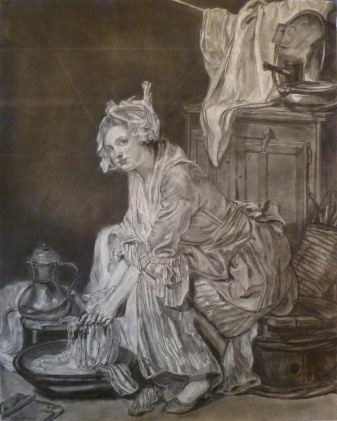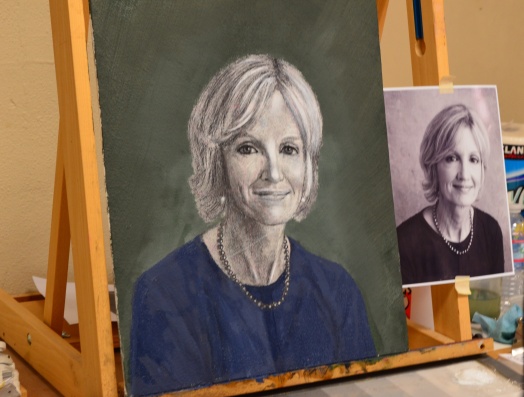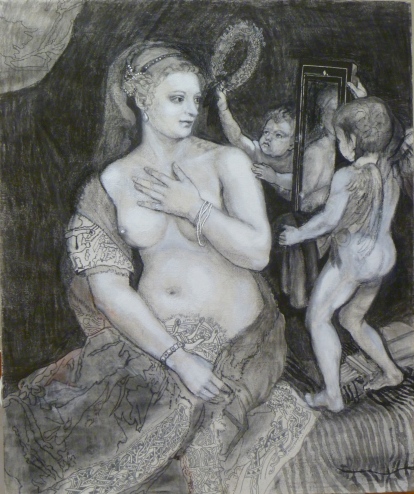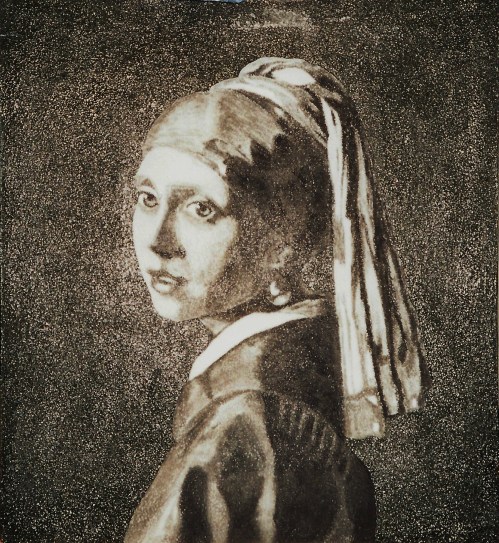Although you are copying an Old Master and placement has already been decided for you, here are some thoughts to keep in mind in the future when you begin composing your own work: if you leave a large space above the head, you will signal to the viewer that the person you are depicting is diminutive, whereas, with less space above, you will give the impression of a taller, more imposing figure. This knowledge is especially useful psychologically when you want to make a woman seem more feminine, or a man more masterful. For example, you would probably not want to paint a commissioned portrait of a farmer, a CEO, or a king, with a lot of space above their heads.
Drawing well requires an extensive understanding of proportion, so to help you get a headstart on drawing and line, we will adopt the OMs’ method of using a graph to facilitate a highly accurate enlargement of your chosen painting. Then, as you progress in skill and knowledge of the “rules,” you can begin to break them because you will find you need these guidelines progressively less and less.
Now that you have collected your painting supplies and materials, it is time to do an acetate overlay cartoon, or line drawing, over your 8″ X 10″ reference. Then, you will transfer that same cartoon onto your painting board. Both the acetate AND the board will be gridded. Remember those algebraic equation days where what you do to one side of the equation, you do to the other side? Well, the same idea applies here: what you do to the acetate, you do to the board, no matter how short a guideline may be.
The Cartoon
Work from your grayscale reference from the grided transfer and cartoon, through to the rendering stages. When you “scale up” your reference material to fit your painting surface, the proportions of that reference material must be maintained; otherwise, you will have a final drawing that is out of proportion with perhaps ears too big or fingers too long. Here is an easy procedure to ensure you get it right.
Procedure for Enlarging Reference While Maintaining Correct Proportion
Let’s say you are working from an 10” X 8” photo reference, and you want to paint it as a 26” X 20”.
1. Divide the long length of your desired enlargement by the long length of your photo reference to get a ratio:
26 ÷ 10 = 2.6″
2. Multiply that ratio by the short length of your photo reference. This will tell you what your enlargement’s short side should be in order to maintain correct proportion:
2.6 X 8 = 20.8″
Your painting size will be 20.8″ X 26″
In this example, the size you wanted was 26″ X 20″ but the closest you can get is 26″ X 20.8″—so what can you do? You have a choice at this point of either:
a) increasing your desired painting size to 26″ X 20.8″ (which would leave you with an odd size for framing),
b) rounding down to 26″ X 20″ (more standard size), or
c) decreasing the photo image content by leaving off a small bit of the sides. This would be a very slight adjustment and probably worth it to be able to maintain a more standard size frame.
The Graph
Once you have the correct proportions, use a thin-point red or blue Sharpie and draw a rectangle on the acetate that corresponds proportionately to the size of your board and place it over your drawing. Use pieces of masking tape to secure each side or corner.
- Very lightly draw a big “X” on your surface from corner to corner.
- Draw a cross through the center of the “X.”
- Connect the cross around to make a diamond.
- Finally, divide the graph into fourths by adding two horizontal and two vertical lines.

Lay another piece of acetate on top of the grayscale reference and grid. As with the gridded acetate, also tack this one down with tape. Trace the figure, including as many detailed features as possible. You can use dotted lines or denser lines to indicate shadows or clothing folds. If you make a mistake, remove it with alcohol and a cotton swab, as mistakes made at this stage will only look even more pronounced in your enlargement. Strive for perfection–it will pay off and save you time later on.
*You can take your cartoon outline further, if you find it helps you, by turning it into a value study. Do this by continuing to draw on the acetate to create a value study with lines–closer together indicates darker–farther apart creates lighter areas. When your acetate drawing looks exactly like the reference and you would deem it a good drawing by itself, you are ready to begin transferring it to the painting surface.
On your board, and just as you did on the acetate, draw an “X”, then a cross, then a diamond, then divide it into fourths, both horizontally and vertically. You can use charcoal or pastel pencils for this. Do not use graphite because it can telescope through oil paint over time. You can draw additional lines to aid you, connecting any two points at any angle. Use as many of these as you need to help encase difficult areas like eyes, nose, and mouth. Keep in mind that whatever you do to the board, you do to the acetate. Note where I placed my extra lines:

We’ll continue with inking and gesso/gelatin buildup in later posts.
All the best,
Marsha
P. S. Just a note to remind you of the upcoming workshop—
Hello, dear readers. Here is some information I just sent out to all members of The Arizona Renaissance Art Guild, and I would like to share it with you as well. We are having a one-week workshop where we intensively work on our paintings for one committed week. If you will be in the Phoenix area on October 7-11, 2013, we would like to invite you to attend and perhaps make some new painting friends. Respond to this post if you are interested.
Dear Artists:
Great news! Karen has confirmed the dates for the Arizona Renaissance Art Guild’s one-week workshop. So, are you ready to paint those gorgeous works of art???
It’s PAINTINGPALOOZA time, one whole week to devote to your Classical painting for about $60 – $85 (total for the week), where we artists help each other make our work better and better.
The workshop is scheduled for the week of October 7 – 11, 2013, at the museum. Workshop hours each day are from 9:00 a.m. until ?.
Signing up is simple–just send us an email and please include your phone number in case we need to contact you. We have space for a maximum of 12 people. The more people that sign up, the less the cost!
There is no need for you to send a deposit ahead of time: just RSVP via email to confirm your attendance, and then pay your share when you get there.
And as always, if you see someone who didn’t get this email but who should or wants to be on the mailing list, please feel free to forward this on to them and us so that we will be able to include them in our next mailing.
Call if you have any questions. Looking forward to hearing from you soon,
Karen and Marsha
Arizona Renaissance Art Guild















































